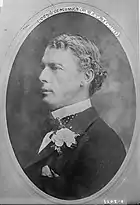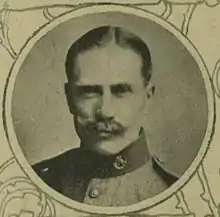Peebles and Selkirk (UK Parliament constituency)
Peebles and Selkirk was a county constituency of the House of Commons of the Parliament of the United Kingdom (Westminster) from 1868 to 1918. It elected one Member of Parliament (MP) by the first past the post voting system.
| Peebles and Selkirk | |
|---|---|
| Former County constituency for the House of Commons | |
| 1868–1918 | |
| Number of members | One |
| Replaced by | Peebles and Southern Midlothian Roxburgh and Selkirk |
| Created from | Peeblesshire Selkirkshire |
Boundaries
The name relates the constituency to the counties of Peebles and Selkirk.
From 1708 to 1868 the counties had been covered, at least nominally, by the Peeblesshire and Selkirkshire constituencies.
When the Peebles and Selkirk constituency was abolished in 1918, the Peebles and Southern Midlothian and Roxburgh and Selkirk constituencies were created.
Members of Parliament
| Election | Member[1] | Party | Notes | |
|---|---|---|---|---|
| 1868 | Sir Graham Graham-Montgomery, Bt | Conservative | Previously MP for Peeblesshire | |
| 1880 | Charles Tennant | Liberal | ||
| 1886 | Sir Walter Thorburn | Liberal Unionist Party | ||
| 1906 | Alexander Murray, Master of Elibank | Liberal | ||
| Jan. 1910 | William Younger | Liberal | ||
| Dec. 1910 | Sir Donald Maclean | Liberal | Subsequently, MP for Peebles and Southern Midlothian | |
| 1918 | constituency abolished | |||
Elections
Elections in the 1860s
| Party | Candidate | Votes | % | ±% | |
|---|---|---|---|---|---|
| Conservative | Graham Graham-Montgomery | 361 | 50.2 | ||
| Liberal | John Murray[3] | 358 | 49.8 | ||
| Majority | 3 | 0.4 | |||
| Turnout | 719 | 80.9 | |||
| Registered electors | 889 | ||||
| Conservative win (new seat) | |||||
Elections in the 1870s
| Party | Candidate | Votes | % | ±% | |
|---|---|---|---|---|---|
| Conservative | Graham Graham-Montgomery | Unopposed | |||
| Registered electors | 1,026 | ||||
| Conservative hold | |||||
Elections in the 1880s
| Party | Candidate | Votes | % | ±% | |
|---|---|---|---|---|---|
| Liberal | Charles Tennant | 516 | 51.6 | New | |
| Conservative | Graham Graham-Montgomery | 484 | 48.4 | N/A | |
| Majority | 32 | 3.2 | N/A | ||
| Turnout | 1,000 | 88.0 | N/A | ||
| Registered electors | 1,136 | ||||
| Liberal gain from Conservative | Swing | N/A | |||
| Party | Candidate | Votes | % | ±% | |
|---|---|---|---|---|---|
| Liberal | Charles Tennant | 1,746 | 62.7 | +11.1 | |
| Conservative | Graham Graham-Montgomery | 1,038 | 37.3 | −11.1 | |
| Majority | 708 | 25.4 | +22.2 | ||
| Turnout | 2,784 | 85.7 | −2.3 | ||
| Registered electors | 3,250 | ||||
| Liberal hold | Swing | +11.1 | |||
| Party | Candidate | Votes | % | ±% | |
|---|---|---|---|---|---|
| Liberal Unionist | Walter Thorburn | 1,375 | 50.9 | +13.6 | |
| Liberal | Charles Tennant | 1,325 | 49.1 | -13.6 | |
| Majority | 50 | 1.8 | N/A | ||
| Turnout | 2,700 | 83.1 | -2.6 | ||
| Registered electors | 3,250 | ||||
| Liberal Unionist gain from Liberal | Swing | +13.6 | |||
Elections in the 1890s

| Party | Candidate | Votes | % | ±% | |
|---|---|---|---|---|---|
| Liberal Unionist | Walter Thorburn | 1,603 | 54.0 | +3.1 | |
| Liberal | Thomas Gibson-Carmichael | 1,367 | 46.0 | -3.1 | |
| Majority | 236 | 8.0 | +6.2 | ||
| Turnout | 2,970 | 87.4 | +4.3 | ||
| Registered electors | 3,400 | ||||
| Liberal Unionist hold | Swing | +3.1 | |||
| Party | Candidate | Votes | % | ±% | |
|---|---|---|---|---|---|
| Liberal Unionist | Walter Thorburn | 1,563 | 50.9 | -3.1 | |
| Liberal | Alexander Murray | 1,509 | 49.1 | +3.1 | |
| Majority | 54 | 1.8 | -6.2 | ||
| Turnout | 3,072 | 87.7 | +0.3 | ||
| Registered electors | 3,504 | ||||
| Liberal Unionist hold | Swing | -3.1 | |||
Elections in the 1900s

| Party | Candidate | Votes | % | ±% | |
|---|---|---|---|---|---|
| Liberal Unionist | Walter Thorburn | 1,598 | 53.5 | +2.6 | |
| Liberal | Edward Tennant | 1,387 | 46.5 | -2.6 | |
| Majority | 211 | 7.0 | +5.2 | ||
| Turnout | 2,985 | 82.8 | -4.9 | ||
| Registered electors | 3,603 | ||||
| Liberal Unionist hold | Swing | +2.6 | |||

| Party | Candidate | Votes | % | ±% | |
|---|---|---|---|---|---|
| Liberal | Alexander Murray | 1,955 | 55.8 | +9.3 | |
| Liberal Unionist | Walter Thorburn | 1,549 | 44.2 | -9.3 | |
| Majority | 406 | 11.6 | N/A | ||
| Turnout | 3,504 | 91.5 | +8.7 | ||
| Registered electors | 3,830 | ||||
| Liberal gain from Liberal Unionist | Swing | +9.3 | |||
Elections in the 1910s

| Party | Candidate | Votes | % | ±% | |
|---|---|---|---|---|---|
| Liberal | William Younger | 1,941 | 52.8 | -3.0 | |
| Liberal Unionist | Samuel Strang Steel | 1,735 | 47.2 | +3.0 | |
| Majority | 206 | 5.6 | -6.0 | ||
| Turnout | 3,676 | 91.2 | -0.3 | ||
| Liberal hold | Swing | -3.0 | |||

| Party | Candidate | Votes | % | ±% | |
|---|---|---|---|---|---|
| Liberal | Donald Maclean | 1,965 | 52.7 | -0.1 | |
| Liberal Unionist | Samuel Strang Steel | 1,764 | 47.3 | +0.1 | |
| Majority | 201 | 5.4 | -0.2 | ||
| Turnout | 3,729 | 90.8 | -0.4 | ||
| Liberal hold | Swing | -0.1 | |||
General Election 1914/15:
Another General Election was required to take place before the end of 1915. The political parties had been making preparations for an election to take place and by the July 1914, the following candidates had been selected;
- Liberal: Donald Maclean
- Unionist: John Buchan
References
- Leigh Rayment's Historical List of MPs – Constituencies beginning with "P" (part 1)
- Craig, F. W. S., ed. (1977). British Parliamentary Election Results 1832-1885 (e-book)
|format=requires|url=(help) (1st ed.). London: Macmillan Press. ISBN 978-1-349-02349-3. - "Counties of Peebles and Selkirk". Glasgow Herald. 26 November 1868. p. 7. Retrieved 14 March 2018 – via British Newspaper Archive.
- Debrett's House of Commons and Judicial Bench, 1889
- Craig, FWS, ed. (1974). British Parliamentary Election Results: 1885-1918. London: Macmillan Press. ISBN 9781349022984.
- Whitaker's Almanack, 1892
- Debrett's House of Commons and the Judicial Bench, 1901
- Whitaker's Almanack, 1907
- Debrett's House of Commons and the Judicial Bench, 1916
